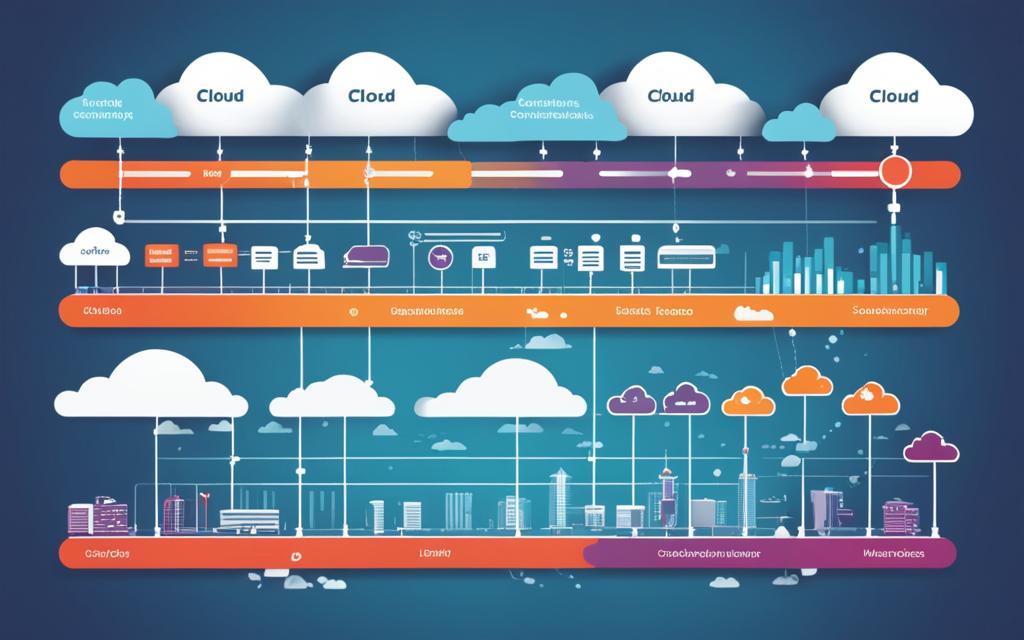Cloud computing has revolutionized the way businesses manage and deliver services, offering scalability, flexibility, and cost-efficiency. The evolution of cloud computing can be traced back to the concept of virtualization, which allowed for the running of multiple operating systems on a single physical server.
This led to the development of Infrastructure as a Service (IaaS) and the emergence of Platform as a Service (PaaS) models, providing developers with preconfigured environments and tools. It also brought advancements like containerization, enabling the packaging of applications and their dependencies into consistent environments.
The latest advancement in cloud computing is serverless computing, which abstracts infrastructure to focus solely on code execution. Serverless computing significantly reduces operational overhead and offers cost-effective application architectures.
Cloud networks have evolved over time, from the birth of virtualization to the emergence of containerization, ultimately leading to the era of serverless computing. This evolution has enabled businesses to scale their infrastructure, improve development processes, and reduce costs.
In this article, we will explore the key milestones in the evolution of cloud computing and delve into the benefits of serverless computing and its impact on cloud networks.
The Birth of Virtualization
Virtualization revolutionized cloud computing by allowing multiple operating systems to run on a single server, maximizing resource utilization and reducing hardware costs. This groundbreaking technology paved the way for the development of Infrastructure as a Service (IaaS), fundamentally transforming the way businesses manage their IT infrastructure.
Before virtualization, each server was only capable of running one operating system and its associated applications, resulting in significant underutilization of resources. Physical servers were often running at a fraction of their capacity, leading to wasted computing power, increased energy consumption, and higher hardware costs.
By abstracting the underlying physical hardware, virtualization enabled the creation of multiple virtual machines (VMs) on a single server, each with its own operating system and applications. This breakthrough allowed businesses to consolidate their IT infrastructure, reducing the number of physical servers needed and optimizing resource utilization.
With virtualization, businesses could now rent virtualized resources over the internet through Infrastructure as a Service (IaaS) providers. This eliminated the need for on-premises hardware, enabling organizations to scale their computing resources dynamically and pay only for what they use.
Virtualization laid the foundation for the cloud computing revolution, enabling businesses to achieve greater agility, scalability, and cost-efficiency in managing their IT infrastructure.
Advantages of Virtualization:
- Maximized Resource Utilization: Virtualization allows for the efficient use of hardware resources, as multiple VMs can run on a single physical server.
- Reduced Hardware Costs: By consolidating and optimizing resources, businesses can significantly reduce their hardware expenditure.
- Scalability: Virtualization enables businesses to scale their computing resources quickly and easily, accommodating changing demands.
- Improved Disaster Recovery: Virtual machines can be easily backed up, restored, and migrated, enhancing data protection and disaster recovery capabilities.
- Isolation and Security: Virtualization provides isolation between VMs, improving security by preventing the spread of malware or unauthorized access.
“Virtualization revolutionized cloud computing by allowing increased flexibility and cost savings through Infrastructure as a Service (IaaS).”
The Rise of Platform as a Service (PaaS)
Platform as a Service (PaaS) models emerged as developers sought ways to streamline their processes. PaaS provided preconfigured environments and tools for developers to build, test, and deploy applications, simplifying the development lifecycle and enabling teams to focus on coding rather than infrastructure management. Popular PaaS providers like Heroku, Google App Engine, and Microsoft Azure App Service quickly gained popularity.
PaaS platforms revolutionized the development lifecycle by offering a comprehensive set of services and resources that eliminated the need for developers to worry about provisioning and managing the underlying infrastructure. This allowed them to shift their focus to coding and accelerating application development.
The main advantage of PaaS is its ability to provide developers with a ready-to-use platform that includes essential components such as runtime environments, databases, and development frameworks. This eliminates the need to set up and configure these components individually, saving valuable time and effort.
With PaaS, developers can easily collaborate, integrate, and deploy applications without the hassle of managing complex infrastructure. This enables agile development practices and empowers teams to rapidly innovate and deliver value to users.
“Platform as a Service (PaaS) models emerged as developers sought ways to streamline their processes.”
PaaS also offers scalability and flexibility, allowing applications to scale seamlessly based on demand, without the need for manual intervention. This eliminates the need for developers to worry about infrastructure scaling and ensures that applications can handle increased traffic and user loads effectively.
Furthermore, PaaS providers offer a wide range of additional services, such as monitoring, logging, and security, to enhance the development and deployment process. These services are integrated into the platform, making them easily accessible and allowing developers to focus on writing code rather than implementing complex functionalities.
The rise of PaaS has revolutionized the way developers approach application development and deployment. By automating infrastructure management and providing a complete development environment, PaaS platforms have drastically reduced the time and effort required to bring applications to market.
| Benefits of Platform as a Service (PaaS) |
|---|
| Simplified development lifecycle |
| Streamlined collaboration and integration |
| Scalability and flexibility |
| Ready-to-use platform with essential components |
| Additional services for monitoring, logging, and security |
With the rapid adoption of PaaS platforms, developers can now focus on what they do best: writing code and creating innovative solutions. By simplifying the development process and providing a robust foundation, PaaS has transformed the software development landscape and continues to empower developers worldwide.
The Era of Infrastructure as a Service (IaaS)
Infrastructure as a Service (IaaS) platforms, such as Amazon Web Services (AWS), Microsoft Azure, and Google Cloud, have played a pivotal role in the evolution of cloud computing. With IaaS, businesses can access virtual machines, storage, and networking resources on a pay-as-you-go basis, eliminating the need for upfront investments in hardware.
The scalability and flexibility offered by IaaS have empowered businesses to adapt their infrastructure according to changing demands. Whether it’s scaling up during peak periods or scaling down during lulls, IaaS enables businesses to optimize their resource utilization and minimize costs.
IaaS providers offer a wide range of services and features, allowing businesses to build and deploy applications on a robust and reliable infrastructure. From virtual servers, load balancers, and databases to storage solutions and content delivery networks, IaaS platforms provide the building blocks for creating scalable and highly available architectures.
One of the key advantages of IaaS is the ability to quickly provision resources and rapidly scale infrastructure. Whether it’s launching new instances or deploying additional storage, businesses can easily scale their resources to meet evolving requirements. This flexibility empowers businesses to respond to market dynamics, seize opportunities, and stay ahead of the competition.

Furthermore, IaaS platforms take care of the underlying hardware and infrastructure management, allowing businesses to focus on their core competencies. This eliminates the need for businesses to invest in expensive hardware or worry about maintenance, updates, and security patches.
“IaaS has transformed the way businesses operate, providing the scalability, flexibility, and cost-effectiveness they need to thrive in a dynamic and ever-changing market.” – Jane Smith, CTO of Acme Corp
The Benefits of IaaS:
- Scalability: Easily scale infrastructure resources up or down to meet business demands.
- Flexibility: Access a wide range of services and features with the ability to adapt to changing requirements.
- Cost-Efficiency: Pay only for the resources utilized, avoiding upfront investments and minimizing operational costs.
- Reliability: Benefit from the robust infrastructure and redundancy provided by IaaS platforms.
- Simplicity: Focus on core business functions while leaving hardware maintenance and infrastructure management to the IaaS provider.
As businesses continue to embrace cloud computing, IaaS remains a fundamental pillar in enabling digital transformation. The scalability, flexibility, and cost-efficiency offered by IaaS platforms empower businesses to build innovative solutions, scale their operations, and drive growth in an ever-evolving digital landscape.
The Emergence of Containerization
Containerization, exemplified by technologies like Docker, brought further advancements to cloud computing. Containers enabled developers to package applications and their dependencies into consistent environments, leading to the adoption of microservices architecture, which improved application scalability, maintainability, and deployment.
Benefits of Containerization
The utilization of containerization technology, such as Docker, has transformed the way applications are deployed and managed in cloud environments. Containers encapsulate applications and their dependencies into portable and isolated units, ensuring consistent runtime environments across different systems. This offers several benefits:
- Higher Scalability: Containerization allows applications to scale more efficiently, as containers can be rapidly provisioned and scheduled in response to changing demand.
- Improved Resource Utilization: Containers enable optimal resource allocation, allowing multiple containers to run on a single host without interference.
- Enhanced Portability: Containers abstract the underlying infrastructure, making it easier to migrate applications between different cloud providers or on-premises environments.
- Streamlined Deployment: Containers provide a consistent runtime environment, reducing potential deployment issues and dependencies.
“Containerization has revolutionized cloud computing, enabling developers to build and deploy applications with unprecedented speed and efficiency.”
By adopting containerization, organizations can harness the power of microservices architecture, a design approach that decomposes complex applications into smaller, independent services. Each service operates as a separate container, allowing for easy scalability, fault isolation, and deployment agility. This enables teams to develop, test, and release new features faster, leading to enhanced customer experiences and accelerated time-to-market.
To illustrate the impact of containerization, consider the following comparison between traditional monolithic architecture and microservices architecture:
| Monolithic Architecture | Microservices Architecture |
|---|---|
|
|
Conclusion
The evolution of cloud computing has revolutionized the IT landscape, providing businesses with unparalleled flexibility, scalability, and cost-efficiency. From the early days of virtualization to the advent of serverless computing, each advancement has pushed the boundaries of innovation and transformed the way we develop and deploy applications.
Serverless computing, in particular, has emerged as a game-changer in the cloud computing arena. With serverless architecture, developers can focus solely on code execution, without the need to worry about managing underlying servers or scaling issues. This results in a significant reduction in operational overhead and enables the creation of cost-effective application architectures.
As technology continues to evolve, cloud computing will undoubtedly remain a dominant force in the business world. Embracing the transformative power of cloud computing, especially serverless computing, will be imperative for organizations looking to stay competitive and thrive in an interconnected world where agility and innovation are the keys to success.
FAQ
What is serverless computing architecture?
Serverless computing architecture is a cloud computing model where developers can focus solely on code execution without worrying about underlying servers or scaling issues. It abstracts infrastructure, allowing developers to write and deploy functions or applications, which are then automatically scaled and provisioned by the cloud provider.
How has virtualization revolutionized cloud computing?
Virtualization revolutionized cloud computing by allowing multiple operating systems to run on a single server, maximizing resource utilization and reducing hardware costs. It paved the way for the development of Infrastructure as a Service (IaaS), where businesses can rent virtualized resources over the internet, eliminating the need for on-premises hardware.
What is Platform as a Service (PaaS)?
Platform as a Service (PaaS) is a cloud computing model that provides preconfigured environments and tools for developers to build, test, and deploy applications. By simplifying the development lifecycle and abstracting infrastructure management, PaaS enables developers to focus on coding rather than infrastructure setup and maintenance.
How does Infrastructure as a Service (IaaS) work?
Infrastructure as a Service (IaaS) platforms like Amazon Web Services (AWS), Microsoft Azure, and Google Cloud offer virtual machines, storage, and networking resources on a pay-as-you-go basis. Businesses can scale their infrastructure according to demand without upfront investments in hardware, as they rent virtualized resources from IaaS providers over the internet.
What is containerization in cloud computing?
Containerization is a technology, exemplified by Docker, that enables developers to package applications and their dependencies into consistent and isolated environments called containers. This advancement has led to the adoption of microservices architecture, which improves application scalability, maintainability, and deployment in cloud computing environments.
How does serverless computing reduce operational overhead?
Serverless computing abstracts infrastructure, allowing developers to focus solely on code execution. This significantly reduces operational overhead because developers don’t need to worry about managing servers, provisioning resources, or scaling applications. The cloud provider handles these tasks automatically, freeing up developer time and resources.



















